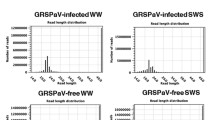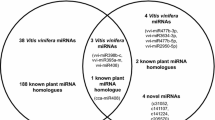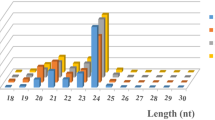Abstract
Grapevine is one of the economically and culturally important perennial fruit crops. More than 60 viruses infect grapevines and adversely affect their growth and development. Latent infection of most viruses in grapevines leads to chronic modulation of gene expression at transcriptional and post-transcriptional levels. Plant small RNAs (sRNAs) consist of microRNA (miRNA) and small interfering RNA (siRNA). miRNAs are expressed from the plant genome while most siRNAs are derived from double-stranded RNA molecules which are intermediates during virus replication. In a previous study, we constructed four cDNA libraries of sRNAs that were enriched from three virus-infected grapevines and one virus-free grapevine. Majority of siRNAs align most closely with the genomes of DNA viruses in the genus Badnavirus, family Caulimoviridae that led to the discovery of a new Grapevine vein clearing virus in grapevines. In this study, we conducted a comprehensive analysis of miRNAs in the four cDNA libraries and identified novel and stress-related miRNAs. The results indicated that miRNA abundance was influenced by virus infection. A total of 54 new miRNAs were identified and characterized, six of which, VITIS-MIR17, 18, 19, 20, 21, and 22, were detected only in virus-infected samples. One target of VITIS-MIR18 is the gene coding a non-apical meristem protein (GSVIVT00035370001), a transcription factor in the regulation of plant development and stress responses. Among the virus infection-induced known miRNAs, miRNA168 and miRNA3623 likely regulate grapevine’s defense response, miRNA319 and miRNA395 modulate the expression of genes that are involved in nutrient metabolisms while miRNA396 plays a role in the regulation of cell division and cell cycle. The abiotic stress-induced miR169 and mi398 were negatively regulated by virus infection in grapevines. In addition, variety-specific miRNAs were discovered and compiled. The newly discovered miRNAs expand the miRNA profiles in the Vitis species. The characteristics of variety-specific and virus infection-associated miRNAs help understand the biology underlying the development and defense response of grapevines.


Similar content being viewed by others
References
Amin I, Patil B, Briddon R, Mansoor S, Fauquet C (2011) Comparison of phenotypes produced in response to transient expression of genes encoded by four distinct begomoviruses in Nicotiana benthamiana and their correlation with the levels of developmental miRNAs. Virol J 8(1):238
Bartel DP (2009) MicroRNAs: target recognition and regulatory functions. Cell 136(2):215–233
Bazzini AA, Hopp HE, Beachy RN, Asurmendi S (2007) Infection and coaccumulation of tobacco mosaic virus proteins alter microRNA levels, correlating with symptom and plant development. Proc Natl Acad Sci USA 104(29):12157–12162
Bazzini A, Almasia N, Manacorda C, Mongelli V, Conti G, Maroniche G, Rodriguez M, Distefano A, Hopp HE, del Vas M et al (2009) Virus infection elevates transcriptional activity of miR164a promoter in plants. BMC Plant Biol 9(1):152
Buhtz A, Pieritz J, Springer F, Kehr J (2010) Phloem small RNAs, nutrient stress responses, and systemic mobility. BMC Plant Biol 10(1):64
Carra A, Mica E, Gambino G, Pindo M, Moser C, Pè ME, Schubert A (2009) Cloning and characterization of small non-coding RNAs from grape. Plant J 59:750–763
Carthew RW, Sontheimer EJ (2009) Origins and mechanisms of miRNAs and siRNAs. Cell 136(4):642–655
Dunoyer P, Schott G, Himber C, Meyer D, Takeda A, Carrington JC, Voinnet O (2010) Small RNA duplexes function as mobile silencing signals between plant cells. Science 328(5980):912–916
Fahlgren N, Howell MD, Kasschau KD, Chapman EJ, Sullivan CM, Cumbie JS, Givan SA, Law TF, Grant SR, Dangl JL et al (2007) High-throughput sequencing of Arabidopsis microRNAs: evidence for frequent birth and death of MIRNA genes. PLoS One 2(2):e219
Fahlgren N, Jogdeo S, Kasschau KD, Sullivan CM, Chapman EJ, Laubinger S, Smith LM, Dasenko M, Givan SA, Weigel D et al (2010) MicroRNA gene evolution in Arabidopsis lyrata and Arabidopsis thaliana. Plant Cell 22(4):1074–1089
Feng J, Lai L, Lin R, Jin C, Chen J (2012) Differential effects of Cucumber mosaic virus satellite RNAs in the perturbation of microRNA-regulated gene expression in tomato. Mol Biol Rep 39:775–784
Fung RWM, Gonzalo M, Fekete C, Kovacs LG, He Y, Marsh E, McIntyre LM, Schachtman DP, Qiu WP (2008) Powdery mildew induces defense-oriented reprogramming of the transcriptome in a susceptible but not in a resistant grapevine. Plant Physiol 146:236–249
Gournas C, Papageorgiou I, Diallinas G (2008) The nucleobase–ascorbatetransporter (NAT) family: genomics, evolution, structure–function relationships and physiological role. Mol Biosyst 4:404–416
Hu Q, Hollunder J, Niehl A, Karner CJ, Gereige D, Windels D, Arnold A, Kuiper M, Vazquez F, Pooggin M et al (2011) Specific impact of Tobamovirus infection on the Arabidopsis small RNA profile. PLoS One 6(5):e19549
Jaillon O, Aury J, Noel B, Policriti A, Clepet C, Casagrande A, Choisne N, Aubourg S, Vitulo N, Jubin C et al (2007) The grapevine genome sequence suggests ancestral hexaploidization in major angiosperm phyla. Nature 449:463–467
Katiyar-Agarwal S, Jin H (2010) Role of small RNAs in host–microbe interactions. Annu Rev Phytopathol 48:225–246
Kawashima CG, Matthewman CA, Huang S, Lee B-R, Yoshimoto N, Koprivova A, Rubio-Somoza I, Todesco M, Rathjen T, Saito K et al (2011) Interplay of SLIM1 and miR395 in the regulation of sulfate assimilation in Arabidopsis. Plant J 66(5):863–876
Liang G, Yang F, Yu D (2010) MicroRNA395 mediates regulation of sulfate accumulation and allocation in Arabidopsis thaliana. Plant J 62(6):1046–1057
Meyers BC, Axtell MJ, Bartel B, Bartel DP, Baulcombe D, Bowman JL, Cao X, Carrington JC, Chen X, Green PJ et al (2008) Criteria for annotation of plant microRNAs. Plant Cell 20(12):3186–3190
Mica E, Piccolo V, Delledonne M, Ferrarini A, Pezzotti M, Casati C, Del Fabbro C, Valle G, Policriti A, Morgante M et al (2010) Correction: high throughput approaches reveal splicing of primary microRNA transcripts and tissue specific expression of mature microRNAs in Vitis vinifera. BMC Genomics 11(1):109
Molnar A, Melnyk CW, Bassett A, Hardcastle TJ, Dunn R, Baulcombe DC (2010) Small silencing RNAs in plants are mobile and direct epigenetic modification in recipient cells. Science 328(5980):872–875
Moxon S, Schwach F, Dalmay T, Maclean D, Studholme DJ, Moulton V (2008) A toolkit for analysing large-scale plant small RNA datasets. Bioinformatics 24:2252–2253
Myles S, Boyko AR, Owens CL, Brown PJ, Grassi F, Aradhya MK, Prins B, Reynolds A, Chia J-M, Ware D et al (2011) Genetic structure and domestication history of the grape. Proc Natl Acad Sci USA 108(9):3530–3535
Naqvi A, Haq Q, Mukherjee S (2010) MicroRNA profiling of tomato leaf curl new delhi virus (tolcndv) infected tomato leaves indicates that deregulation of mir159/319 and mir172 might be linked with leaf curl disease. Virol J 7(1):281
Olsen AN, Ernst HA, Leggio LL, Skriver K (2005) NAC transcription factors: structurally distinct, functionally diverse. Trends Plant Sci 10(2):79–87
Pantaleo V, Szittya G, Moxon S, Miozzi L, Moulton V, Dalmay T, Burgyan J (2010) Identification of grapevine microRNAs and their targets using high-throughput sequencing and degradome analysis. Plant J 62(6):960–976
Perez-Quintero A, Neme R, Zapata A, Lopez C (2010) Plant microRNAs and their role in defense against viruses: a bioinformatics approach. BMC Plant Biol 10(1):138
Rajagopalan R, Vaucheret H, Trejo J, Bartel DP (2006) A diverse and evolutionarily fluid set of microRNAs in Arabidopsis thaliana. Genes Dev 20:3407–3425
Sunkar R, Zhu J (2004) Novel and stress-regulated microRNAs and other small RNAs from Arabidopsis. Plant Cell 16(8):2001–2019
Sunkar R, Chinnusamy V, Zhu J, Zhu J-K (2007) Small RNAs as big players in plant abiotic stress responses and nutrient deprivation. Trends Plant Sci 12(7):301–309
Tagami Y, Inaba N, Kutsuna N, Kurihara Y, Watanabe Y (2007) Specific enrichment of miRNAs in Arabidopsis thaliana infected with tobacco mosaic virus. DNA Res 14(5):227–233
Trindade I, Capitão C, Dalmay T, Fevereiro M, Santos D (2010) miR398 and miR408 are up-regulated in response to water deficit in Medicago truncatula. Planta 231(3):705–716
Varallyay E, Valoczi A, Agyi A, Burgyan J, Havelda Z (2010) Plant virus-mediated induction of miR168 is associated with repression of ARGONAUTE1 accumulation. EMBO J 29(20):3507–3519
Velasco R, Zharkikh A, Troggio M, Cartwright DA, Cestaro A, Pruss D, Pindo M, FitzGerald LM, Vezzulli S, Reid J et al (2007) A high quality draft consensus sequence of the genome of a heterozygous grapevine variety. PLoS One 2(12):e1326
Voinnet O (2009) Origin, biogenesis, and activity of plant microRNAs. Cell 136(4):669–687
Wang C, Wang X, Kibet NK, Song C, Zhang C, Li X, Han J, Fang J (2011a) Deep sequencing of grapevine flower and berry short RNA library for discovery of novel microRNAs and validation of precise sequences of grapevine microRNAs deposited in miRBase. Physiol Plant 143:64–81
Wang L, Gu X, Xu D, Wang W, Wang H, Zeng M, Chang Z, Huang H, Cui X (2011b) miR396-targeted AtGRF transcription factors are required for coordination of cell division and differentiation during leaf development in Arabidopsis. J Exp Bot 62(2):761–773
Yoo SY, Kim Y, Kim SY, Lee JS, Ahn JH (2007) Control of flowering time and cold response by a NAC-domain protein in Arabidopsis. PLoS One 2(7):e642
Zhang X, Yuan Y-R, Pei Y, Lin S-S, Tuschl T, Patel DJ, Chua N-H (2006) Cucumber mosaic virus-encoded 2b suppressor inhibits Arabidopsis Argonaute1 cleavage activity to counter plant defense. Genes Dev 20(23):3255–3268
Zhang Y, Singh K, Kaur R, Qiu W (2011a) Association of a novel DNA virus with the grapevine vein-clearing and vine decline syndrome. Phytopathology 9:1081–1090
Zhang X, Zou Z, Gong P, Zhang J, Ziaf K, Li H, Xiao F, Ye Z (2011b) Over-expression of microRNA169 confers enhanced drought tolerance to tomato. Biotechnol Lett 33(2):403–409
Zhao M, Ding H, Zhu J, Zhang F, Li WX (2011) Involvement of miRNA169 in the nitrogen-starvation responses in Arabidopsis. New Phytol 190:906–915
Zhu C, Ding Y, Liu H (2011) miRNA398 and plant stress responses. Physiol Plant. doi:10.1111/j.1399-3054.2011.01477.x
Acknowledgments
This project was supported by USDA-CSREES (2009-38901-19962) grant to WQ. We thank Chin-Feng Hwang for critical reviewing of the manuscript. We are indebted to Brian Dalley in the Microarray and Genomic Analysis Core Facility at the University of Utah, Salt Lake City, UT, USA, for technical assistance with construction of small RNA libraries and deep sequencing.
Author information
Authors and Affiliations
Corresponding author
Electronic supplementary material
Below is the link to the electronic supplementary material.
Supplemental Table 1
List of new miRNAs and their predicted target genes (DOCX 25 kb)
Supplemental Table 2
Read count of novel miRNA in each grapevine and their detailed annotations and predicted target genes (XLSX 30 kb)
Supplemental Table 3
Predicted target genes of virus-induced miRNAs in grapevine (DOCX 24 kb)
Rights and permissions
About this article
Cite this article
Singh, K., Talla, A. & Qiu, W. Small RNA profiling of virus-infected grapevines: evidences for virus infection-associated and variety-specific miRNAs. Funct Integr Genomics 12, 659–669 (2012). https://doi.org/10.1007/s10142-012-0292-1
Received:
Revised:
Accepted:
Published:
Issue Date:
DOI: https://doi.org/10.1007/s10142-012-0292-1




